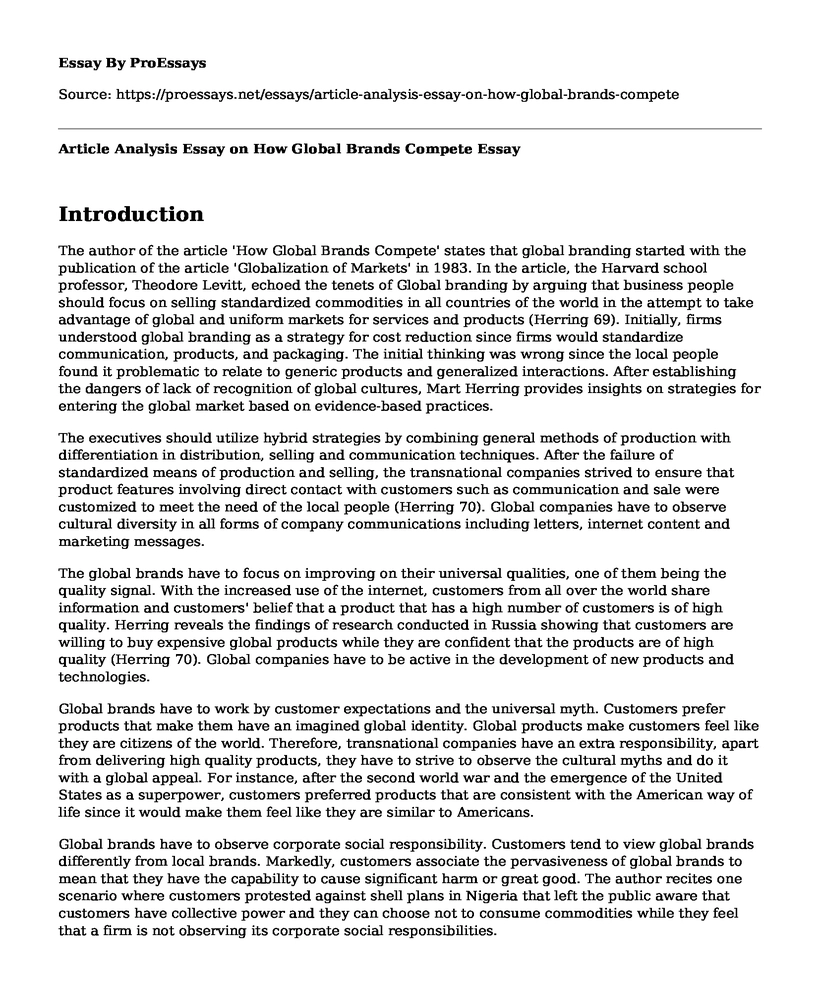Introduction
The author of the article 'How Global Brands Compete' states that global branding started with the publication of the article 'Globalization of Markets' in 1983. In the article, the Harvard school professor, Theodore Levitt, echoed the tenets of Global branding by arguing that business people should focus on selling standardized commodities in all countries of the world in the attempt to take advantage of global and uniform markets for services and products (Herring 69). Initially, firms understood global branding as a strategy for cost reduction since firms would standardize communication, products, and packaging. The initial thinking was wrong since the local people found it problematic to relate to generic products and generalized interactions. After establishing the dangers of lack of recognition of global cultures, Mart Herring provides insights on strategies for entering the global market based on evidence-based practices.
The executives should utilize hybrid strategies by combining general methods of production with differentiation in distribution, selling and communication techniques. After the failure of standardized means of production and selling, the transnational companies strived to ensure that product features involving direct contact with customers such as communication and sale were customized to meet the need of the local people (Herring 70). Global companies have to observe cultural diversity in all forms of company communications including letters, internet content and marketing messages.
The global brands have to focus on improving on their universal qualities, one of them being the quality signal. With the increased use of the internet, customers from all over the world share information and customers' belief that a product that has a high number of customers is of high quality. Herring reveals the findings of research conducted in Russia showing that customers are willing to buy expensive global products while they are confident that the products are of high quality (Herring 70). Global companies have to be active in the development of new products and technologies.
Global brands have to work by customer expectations and the universal myth. Customers prefer products that make them have an imagined global identity. Global products make customers feel like they are citizens of the world. Therefore, transnational companies have an extra responsibility, apart from delivering high quality products, they have to strive to observe the cultural myths and do it with a global appeal. For instance, after the second world war and the emergence of the United States as a superpower, customers preferred products that are consistent with the American way of life since it would make them feel like they are similar to Americans.
Global brands have to observe corporate social responsibility. Customers tend to view global brands differently from local brands. Markedly, customers associate the pervasiveness of global brands to mean that they have the capability to cause significant harm or great good. The author recites one scenario where customers protested against shell plans in Nigeria that left the public aware that customers have collective power and they can choose not to consume commodities while they feel that a firm is not observing its corporate social responsibilities.
Global brands have to work in the understanding of global market segmentation, and they have to strive to meet the expectations of each segment. Global citizens look at the company success as a signal of innovation and progress. They are interested in companies that observe corporate social responsibilities including consumer health and environmental conservation. Another group consists of the global dreamers whose primary concern is for global companies to deliver as per universal myths. The anti-global group doubt whether global brands meet the expected quality. The global agnostics do not evaluate global brands following global attributes instead they compare global products in the same manner they do for local products.
Conclusion
Overall, the author of the article on 'How Global Brands Compete reveals that entry to the global market provides an opportunity for companies to achieve high sales and higher trust among customers. Market research is vital before a firm commence operations in the global market. Customers are the key pillar to every business, and for firms to achieve greater market sustainability, they have to meet customer's needs. Global brands have to meet customer expectations about quality, universal myths, and social responsibilities.
Works Cited
Herring, Matt. How Global Brands Compete. Pp, 69-75
Cite this page
Article Analysis Essay on How Global Brands Compete. (2022, Jul 11). Retrieved from https://proessays.net/essays/article-analysis-essay-on-how-global-brands-compete
If you are the original author of this essay and no longer wish to have it published on the ProEssays website, please click below to request its removal:
- Essay Sample on Ethical Actions Within Organizations
- Leadership as One of the Critical Skills - Essay Sample
- Essay Sample on Target's Stakeholder Relationships
- Software Acquisition Model: Rent, Outsource or Develop In-House? - Essay Sample
- Essay Example on OMO Tag & Imagine Dubai Win Big at Dubai Lynx
- Tesco's Internal & External Conflicts: A Case Study
- Paper Example on Global Strategies for Medifast Ado: Key Considerations







